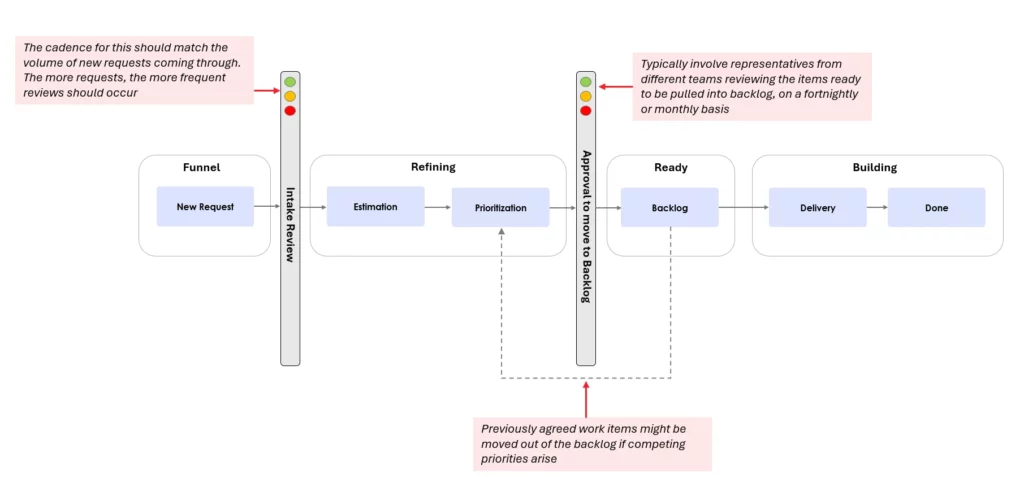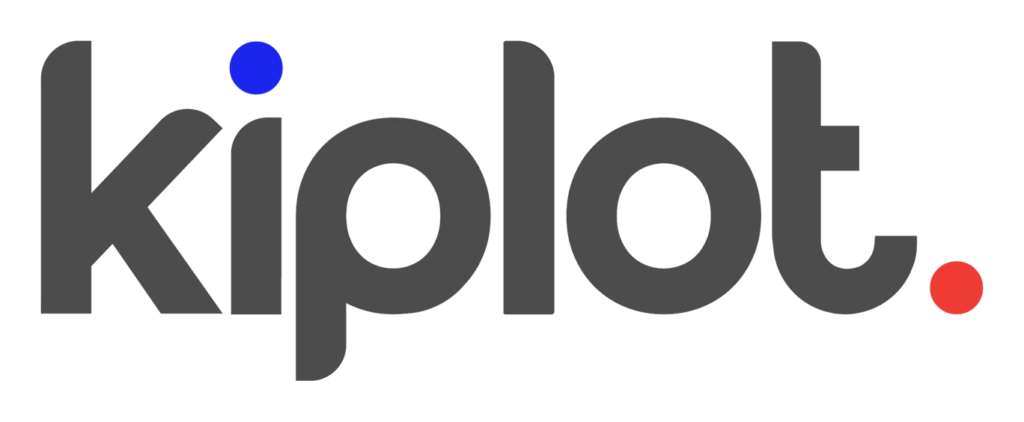Intake Management (also known as Demand Management) is the process of accepting and prioritizing new ideas, requests, and requirements to ensure that initiatives with the highest strategic value and impact in an organization are being prioritized and executed effectively. Whilst it is one of the most crucial elements of the delivery workflow it is often overlooked by organizations. Intake management produces the output for the backlog management process, ensuring that any new work ideas are evaluated and prioritized before being committed to.
In a previous article, we discussed the importance of grip in agile transformation and zoomed in on how Steve Jobs gave the right level of autonomy and decision-making power to his teams so they could solve the hardest problems, without giving them the power to determine the overall direction of the company. In this article, we will delve into the first principle, 'Origination,' in greater detail. Designing the optimal intake management process for your organization depends on several factors, including your business model, agile maturity, technology landscape, and operating model. This article serves as an introductory guide, providing valuable insights regardless of your current starting point.

Portfolio Level vs Team Level
On the surface, it might seem like running the intake management process at the portfolio level is the easiest way to ensure your organization is prioritizing initiatives that are most closely aligned with the strategic business goals. However, this top-down approach can actually result in huge delays and inefficiencies. Teams feel like they’re simply being told what to work on, with no opportunity to provide expertise and insight into the intake planning process. This leans too far towards “control”.
On the flip side, giving teams the power to work on whatever they like, whilst sounding great in practice, in reality leads to chaos. Organizations commonly find themselves with teams working to their own workflows and prioritizing initiatives that don’t align with the wider goals of the organization. This leads to duplication of effort and misalignment.
It is possible to marry the two and arrive at an agile, but controlled intake management process. Teams can be made responsible for their own work intake while having to follow set processes that include regular touchpoints at the portfolio level. These control points ensure that teams reduce the amount of effort that is wasted refining and analyzing work, only for it to eventually be rejected, or “rot” at the bottom of the backlog.
💡 The portfolio Kanban feature in Kiplot allows organizations to do exactly this; you can manage the flow of work at the strategic level, across multiple projects and teams, and ensure alignment with business goals.
Control Points
The diagram below represents an Initiative Intake Management process that all teams in an organization would follow.

The two traffic lights in this diagram represent the control points where work items moving through the process would be reviewed against the wider strategic portfolio. This is just the right amount to ensure you’re not simply disguising a heavily controlled process as something more agile than it actually is. It’s important to make sure you’re actually giving teams authority and decision-making powers, rather than just making it seem like they have them.
The traffic light system is an effective way of managing these control points as it provides clear guidance on whether work items can move to the next stage:
Green – The work item meets requirements and can be moved to the next stage.
Amber – More thought needs to go into the request before we commit further or this isn’t something we should explore right now.
Red – Stop! there is serious reconsideration needed before we commit to this work, or the request is too far removed from current business priorities.
Intake Management: Step by Step
| # | Product Action | Description |
|---|---|---|
| 1 | New Request | A new piece of work is raised. The team completes an initial assessment and decides whether this is something worth looking into further. This involves understanding top level requirements. In some organizations, it may be possible to provide a top level estimate of the resource capacity that may be required. |
| 2 | Intake Review (control point 1) | A wider group reviews the new request with the accompanying high level scoping. This group decides whether this is something which should be refined further. There should be a standardized process across the business for what information is required against a request at intake review and what the criteria is for it being accepted. |
| 3 | Estimation | Initial analysis and refinement should be undertaken, following a defined framework. The framework should identify teams that may be required to be involved, and seek input for the high level estimate. At this stage, it is common for the first Epics within the Initiative to be created as the process of “breaking down” the initiative begins. |
| 4 | Prioritization | The request should also be assigned a priority score according to an organization wide framework. A common framework to use is WSJF. You can learn more about WSJF prioritization on the SAFe website or on our features page. |
| 5 | Approval to move to Backlog (control point 2) | Typically this involves different teams meeting on a frequent basis to review the items that are ready to be pulled into the backlog. Depending on the volume of work items and the cadence of your organizations sprint cycles this could be weekly, fortnightly or monthly. You may also choose to wrap this process around your program increment planning cadence. It’s important to ensure that your backlog is large enough to provide a clear vision and roadmap for upcoming work, but not so big that it becomes unmanageable and cluttered. Items should move out of the backlog and back into refinement if new higher priority items arise. |
| 6 | Backlog | Moving an item into the backlog indicates that the request has been accepted, but is not yet actively being worked on. Items should be kept in the backlog in priority order so that when teams pull in new items to delivery, they pick up the most important items. This is why items in the backlog should consistently be reviewed to ensure they’re still assigned the correct priority as new items move into the work stack. |
| 7 | Delivery | An item is pulled out of the backlog and into delivery for teams to start working on. This is when the requirements document is picked up and the work item moves through stages such as design, development, quality assurance and approval. |
| 8 | Done | The work is signed off as completed. Teams ensure that all the tasks and documentation to close off the piece of work have been complete. For larger work items teams run a retrospective to identify any lessons learnt and opportunities for improvement. |
How to know if you’re getting it right
Getting the intake management process right takes time, and it’s likely you’ll go through several iterations before you find exactly the right configuration and cadence for your organization. It is crucial to get regular feedback from teams on the process and to review certain metrics that demonstrate whether it’s working effectively. Some indicators we’d recommend starting with are:
- Resource utilization & capacity planning: Are all resources being utilized fully, without being over capacity? This can allow you to ensure you have the right resource split across teams and aren’t under-utilizing resources. If teams are running intake properly there should be an accurate estimate of how much time a work item will require and when that time can be committed. It can also help identify where teams might be able to work together and share resources more often.
- Flow time: How long is a request spending in each stage of intake? Are there any obvious bottlenecks in the process? This will allow you to ensure your control points aren’t so controlled and time-consuming that they end up blocking work.
- Backlog depth: This metric assesses the number of work items that are currently pending in the backlog. An optimal backlog depth ensures that there is a steady flow of work items without overwhelming the team. Too shallow a backlog may indicate insufficient input or an overly aggressive intake process, while too deep a backlog suggests potential issues with prioritization, resource allocation, or workflow efficiency. Regularly reviewing backlog depth helps in maintaining a balanced workload, ensuring that teams are not overloaded and can focus on delivering quality outcomes. It also aids in identifying whether the intake process is effective in capturing and triaging new work items in a timely manner.
Conclusion
In conclusion, mastering the intake management process is pivotal for aligning strategic objectives with execution. By balancing control and agility, organizations can create a robust framework that supports efficient prioritization and resource allocation. Regular feedback and continuous improvement are essential to refine this process, ensuring it adapts to the evolving needs of the business. Key metrics such as resource utilization, flow time, and backlog depth provide valuable insights into the effectiveness of the intake process, helping teams to deliver high-impact initiatives consistently. Embracing a well-structured intake management approach not only optimizes workflow but also enhances the overall strategic alignment and operational efficiency of the organization.

